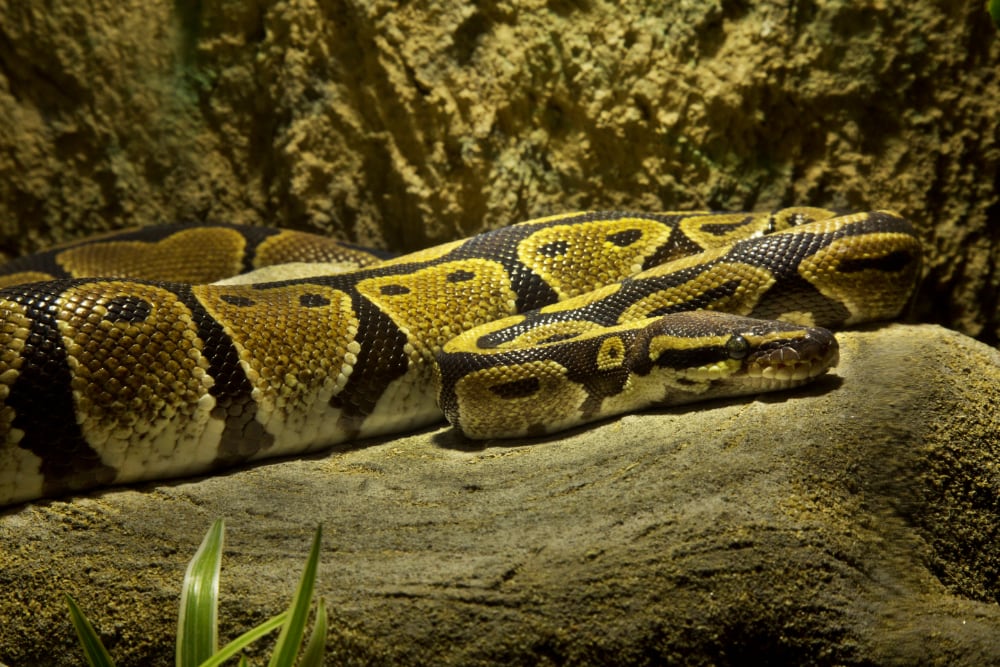Care sheet for the ball python (Python regius).
Updated March 12, 2024
Ball Python (Python regius)
The ball python is quite simply the most popular pet python in the world. Ball pythons are generally a bit shy, but they make for ideal captives, because they are of a small size, are generally friendly, are manageable to care for, and come in a remarkable array of colors and patterns.
Ball pythons are native to central and western Africa and thrive in these warm, tropical areas. They are known as the royal python in many parts of the world and are revered in some areas of Africa.
Ball pythons make for a quality pet for the first-time keeper and experienced herpetoculturists alike. Each year, breeders create incredible, innovative, never-before-seen pattern and color variations that continually generate new fans of the ball python. With reptile health and wellness in mind, this species thrives in captivity.
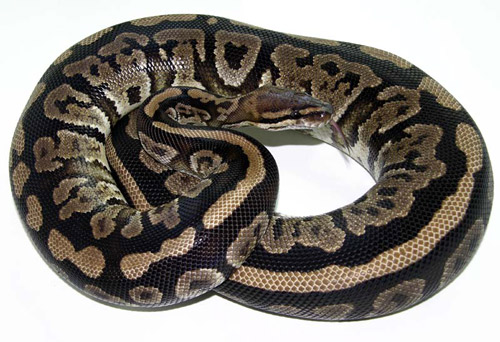
Photo credit: Kevin McCurley
Granite Ball Python.
Ball Python Availability
Ball pythons are quite easy to acquire. They are commonly available from pet stores, reptile breeders, reptile expos, and through online reptile shops and breeders. The best choice will always be captive born and bred snakes because they are usually parasite free and most likely the healthiest. Any ball python should be well-started and eating prior to purchase.
Ball Python Size
Ball python hatchlings are approximately 10 inches in length. Adult female ball pythons average 3 to 5 feet long, and adult male ball pythons average 2 to 3 feet in size. This is a species in which mature females are typically much larger than the males. A 5-foot ball python is considered big, although lengths of 6 feet or more have been reported.
Ball Python Life Span
With proper care, ball pythons can live 30 years or more. The record age for a ball python is more than 40 years – so plan on a long life for your new pet snake.

Photo credit: Kevin McCurley
Spider Killer Bee Axanthic Ball Python.
Ball Python Caging
Ball python enclosures can be as simple or as elaborate as you want to care for when it comes to snake habitat products. Remember that the more you put in the cage, the more you have to clean and disinfect on a regular basis. That said, there are different enclosures that work well for ball pythons, including, but not limited to, plastic sweaterboxes (i.e. Rubbermaid), melamine racks and any of the commercially available, plastic-type reptile cages. Glass reptile terrariums and tanks are adequate for ball pythons, but the screen tops on such enclosures can make it very difficult to maintain proper humidity levels.
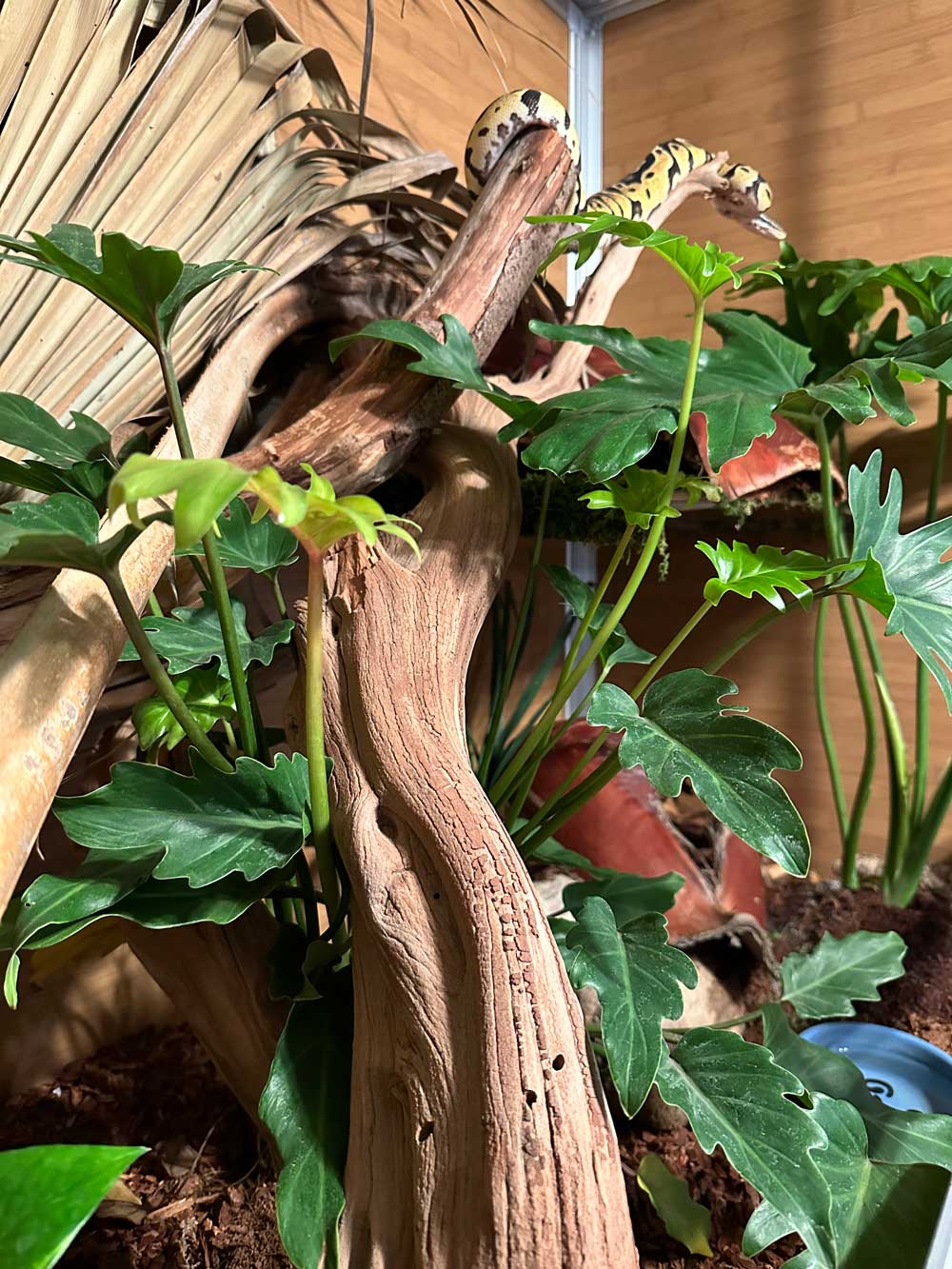
The notion that ball pythons don’t climb is a myth. They do climb and if you provide branches for them to crawl up, they will use them. Photo by John Virata
Juvenile ball pythons seem to do well in small enclosures that make them feel secure. A 4′ x 2′ x 2′ enclosure will more than comfortably house an adult ball python.
Spot-clean your ball python’s enclosure as necessary. Remove feces and urates as soon as possible. Do a complete tear-down every 30 days by removing all substrate and reptile accessories and completely disinfecting with a 5 percent bleach solution. Rinse the enclosure thoroughly with water, and allow it to dry completely before replacing cage accessories and your snake.
The one cage accessory that is required for a happy ball python is a good hide box. . . maybe even a couple of them. Ball pythons are secretive snakes that appreciate and utilize hide spots. Provide one on each end of your python’s enclosure so that it doesn’t have to choose between temperature and security. Clay flowerpots, plastic flowerpot trays and commercially available hide boxes all work well.

Photo credit: Kevin McCurley
Inferno Super Pastel (Super Pastel/Hidden-Gene Woma/Granite/Yellowbelly) Ball Python.
Reptile Heating & Lighting
Remember that enclosures must allow for a proper thermal gradient that the ball python can utilize, with a hotspot on one end of the enclosure and a cool spot on the other. Provide your ball python with a basking spot temperature of 88 to 96 degrees Fahrenheit and an ambient temperature of 78 to 80 degrees. The ambient temperature should not fall below 75 degrees. It is vitally important to know the temperatures at which you are keeping your snake(s). Do not guess! A great way to monitor temperatures is to use a digital indoor/outdoor thermometer with a probe. Stick the thermometer to the inside of the cage on the cool end and place the probe on the warm end, and you’ll have both sides covered at once.
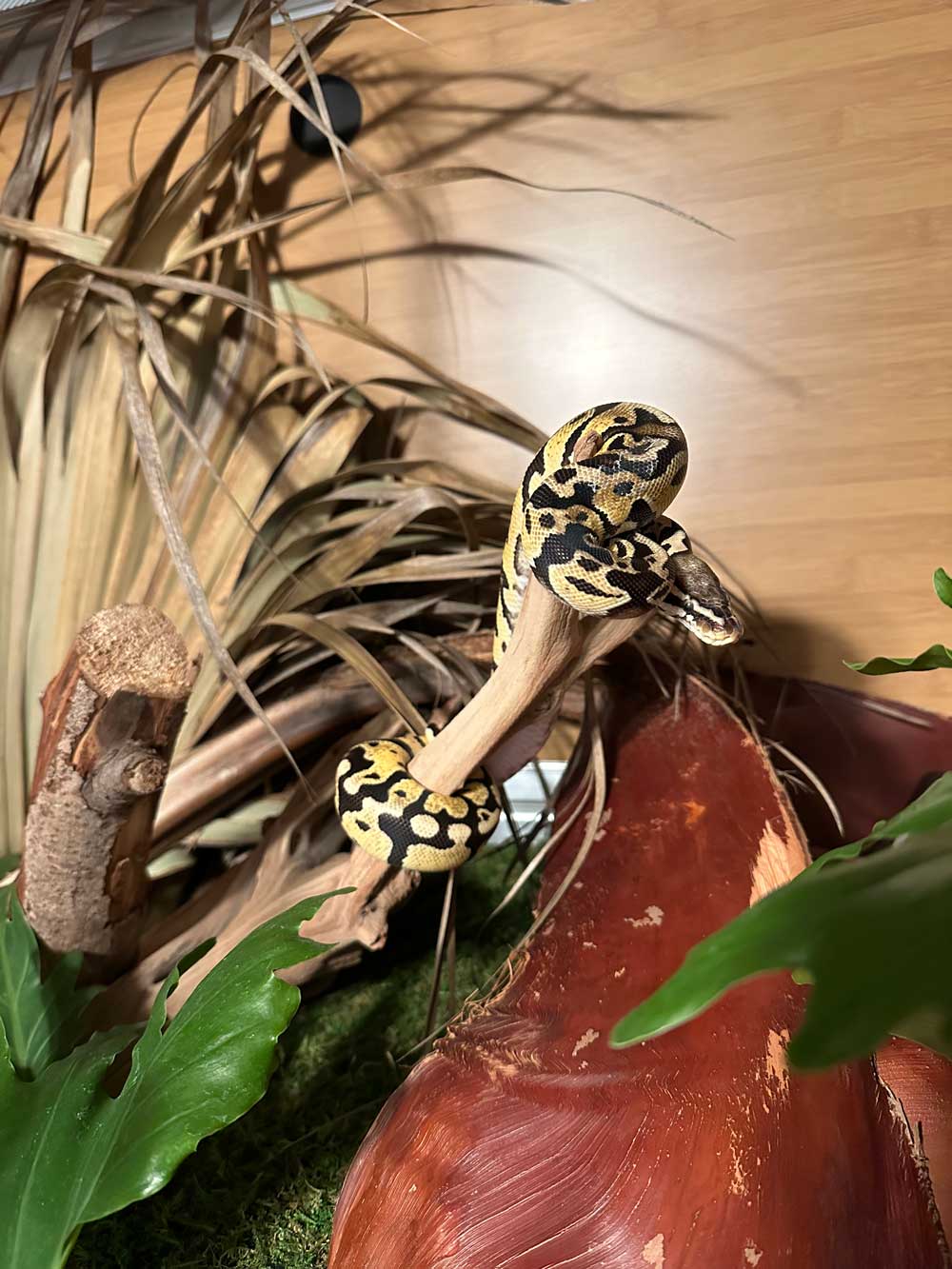
Perches are great additions to your ball python’s enclosure. Photo by John Virata
There are several types of snake heat lamps that help heat a ball python enclosure. Undercage heating pads and tapes, ceramic heat emitters, basking bulbs (both regular daytime and black night bulbs) are just a few. With heat emitters and basking bulbs, it is crucial to keep an eye on the humidity within the enclosure, especially if combined with a screen top, as both will dry the air quickly. Use thermostats, rheostats, and/or reptile timers to control your heat source. Do not use hot rocks with snakes as they can heat unevenly over too small of a surface area and can cause serious burns.
Supplemental lighting is not necessary for ball pythons, but if used should run on a 12/12 cycle, meaning 12 hours on and 12 hours off. Continuous bright, overhead lighting is stressful to snakes, especially a nocturnal species such as the ball python. (Editor’s note: The ball python is a partial sun/occasional basker. It is a Zone 2 reptile under the Ferguson Zones. These zones are based on Dr. Gary Ferguson’s observations of how reptiles interact with sunlight in the wild. Choose a UVB light that offers a Zone range of 0.7 to 1.0 with a maximum UVI of 1.1 to 3.0 in the basking zone). Ball pythons seem to prefer humidity levels of 70 to 80 percent. Maintaining proper humidity will allow your ball python to shed properly.
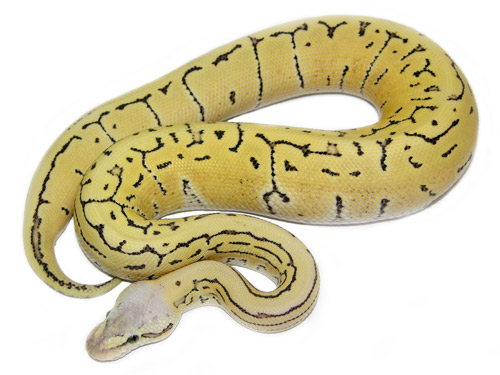
Photo credit: Kevin McCurley
Desert Ghost Lemon Pastel Ball Python.
Snake Substrate
Cypress mulch, coco coir and orchid bark are great substrates for controlling humidity, but remember that too much humidity can be as detrimental (if not more) as too little. Never use any substrate containing cedar, as it contains oils that can be deadly to reptiles! Avoid sand, shavings and peat bedding.
What Food to Feed a Ball Python
Feed your ball python an appropriately sized rodent weekly. “Appropriately sized” means prey items that are no bigger in circumference than the ball python at its largest circumference. Ball pythons can eat rats from the time they are young – starting off with rat pups or “crawlers” at first and moving up in size as they grow. Do not handle your ball python for at least a day after feeding, as this can lead to regurgitation. Ball pythons can be fed frozen/thawed or pre-killed rodents. Never leave a live rodent unattended with any snake, as they can injure the snake.
Ball pythons are well-known for not eating at certain times throughout the year, particularly in the winter months. Be prepared for the possibility of your ball python going off feed, and keep an observant eye on the snake’s overall condition and body weight. This is typically nothing to worry about with healthy, well-established pythons, although it can be extremely frustrating to the snakekeeper. If your ball python is healthy, continue your husbandry routine as usual, but keep the amount of handling to a minimum. Offer your ball python food every 10 to 14 days until it is interested in eating again, as the snake will eventually resume feeding normally.
Feed adult ball pythons every 1 to 2 weeks and younger ball pythons weekly as they need this energy to grow. Do not be alarmed if a well-started ball python goes off feed during the cooler, drier times of the year, as this is common in captivity. Snakes generally do not eat while they are in the shed cycle.

Photo credit: Kevin McCurley
Coral Glow Woma Granite Ball Python.
Ball Python Water
Always have fresh, clean water available for your ball python. Check the water daily. The size of the water dish is up to you. If it is large enough for the ball python to crawl in to and soak, sooner or later your snake will make the most of the opportunity – ball pythons seem to enjoy a nice soak from time to time. Ensure that the water bowl is not too deep for juvenile animals – 1 inch or so will suffice. Snakes of many species will defecate in their water bowls from time to time, so be prepared to clean and disinfect the water bowl. The water bowl should be cleaned and disinfected on a weekly basis. Having a spare water bowl for such occasions can be handy, so that one may be used while the other is being cleaned.
Ball Python Handling and Temperament
Ball pythons are generally shy and will spend much of their time hiding. Your ball python may initially see you as a threat and it must learn who you are. The goal is to establish trust between you and your snake.
Always support your ball python’s body and avoid fast movements. Once a ball python realizes that you will not hurt it they often seem to enjoy being handled. Some ball pythons may try to hide when handled and occasionally there are ones that may even bite due to excessive fear. These ball pythons may require a bit more time to settle in and establish trust. A ball python’s bite is a superficial wound. If a snake looks like it is going to strike, it is best to not handle it. Relax when holding your animal – sit down and give the animal a chance to settle.
Some snakes may not eat for several hours or longer after being handled, so avoid handling if you plan to feed. After a snake has eaten it may be a good idea to limit the handling because it may be uncomfortable for the animal. Avoid putting your snake’s cage in a heavy traffic area, excessive movement, and other pets should be avoided.
Kevin McCurley is the source for Ball Python care and information. Visit his website at NewEnglandReptile.com.

